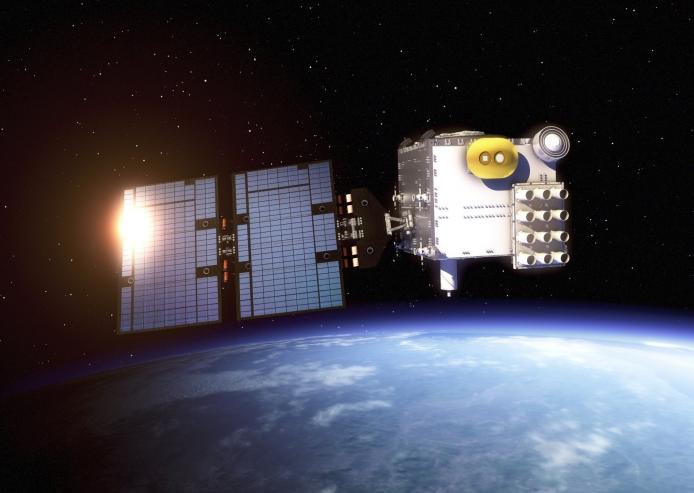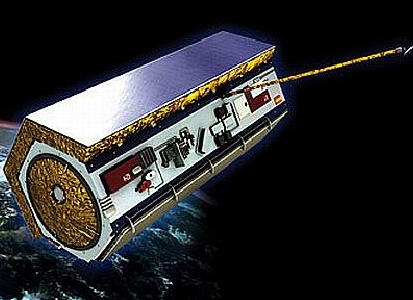STAR GNSS-RO Data Services
COSMIC-2
COSMIC-2 was launched from Kennedy Space Center in Cape Canaveral, Fla. on June 25, 2019
 COSMIC-2 also known as FORMOSAT-7, is
the constellation of satellites for meteorology, ionosphere, climatology, and space weather research.
FORMOSAT-7 is a joint US-Taiwanese project including National Space Organization (NSPO) on the
Taiwanese side and the National Oceanic and Atmospheric Administration (NOAA) and the United States
Air Force (USAF) on the US side. FORMOSAT-7 is the successor of FORMOSAT-3. The six satellites of the
constellation were launched 25 June 2019 on a Falcon Heavy rocket. They reached their designated
mission orbits in February 2021, after eighteen months of gradual orbital adjustments.This team of
COSMIC satellites circles the equator at approximately 17,000 miles per hour and uses a technique
called radio occultation to collect information on our planet’s atmosphere. Here’s how it works:
Global Positioning System (GPS) satellites constantly send signals down to receivers on Earth, but
those signals get distorted along the way because the density of Earth’s atmosphere changes with
height. COSMIC-2 satellites can detect and measure any small bends in those signals before they are
cut off by Earth’s horizon. The three-minute period before the radio signal is cut off is known as
radio occultation, and that data are what gives scientists near real-time information about the
Earth’s atmosphere including conditions such as: temperature, pressure, density and water vapor.
COSMIC-2 also known as FORMOSAT-7, is
the constellation of satellites for meteorology, ionosphere, climatology, and space weather research.
FORMOSAT-7 is a joint US-Taiwanese project including National Space Organization (NSPO) on the
Taiwanese side and the National Oceanic and Atmospheric Administration (NOAA) and the United States
Air Force (USAF) on the US side. FORMOSAT-7 is the successor of FORMOSAT-3. The six satellites of the
constellation were launched 25 June 2019 on a Falcon Heavy rocket. They reached their designated
mission orbits in February 2021, after eighteen months of gradual orbital adjustments.This team of
COSMIC satellites circles the equator at approximately 17,000 miles per hour and uses a technique
called radio occultation to collect information on our planet’s atmosphere. Here’s how it works:
Global Positioning System (GPS) satellites constantly send signals down to receivers on Earth, but
those signals get distorted along the way because the density of Earth’s atmosphere changes with
height. COSMIC-2 satellites can detect and measure any small bends in those signals before they are
cut off by Earth’s horizon. The three-minute period before the radio signal is cut off is known as
radio occultation, and that data are what gives scientists near real-time information about the
Earth’s atmosphere including conditions such as: temperature, pressure, density and water vapor.
- Level 1b
- Atmospheric excess phase (conPhs format, COMING SOON)
- Level 2
- Level 3
- Release notes
- Neutral atmosphere product release notes,COMING SOON
KOMPSAT5
The KOMPSAT-5 (Arirang-5) spacecraft was launched on August 22, 2013 on a Dnepr-1 launch vehicle of ISC Kosmotras from the Dombarovsky Launch Site, Yasny, Russia.
 The goal of the KOMPSAT 5 (Korean Multi-purpose Satellite 5) or Arirang 5 project is to lead the
development of the first Korean SAR Satellite using manpower and facilities from the KOMPSAT-3
program. It aims to support the national SAR (Synthetic Aperture Radar) satellite demand and form a
technology infrastructure to make inroads into the world space industry.
KOMPSAT-5, which was developed since in the middle of 2005, was launched in 2014 and its payload is a
X-band SAR a, which operates at Dawn-Dusk orbit between an altitude of 500 km to 600 km.
It executes all weather and all day observations of the Korean peninsula during its five year mission
using the SAR payload, unlike the optical KOMPSAT-1, -2 and -3 satellites. And in order to meet the
urgent national needs for various SAR image information, the KOMPSAT-5 GOLDEN Mission will provide GIS
(Geographical Information Systems), Ocean monitoring, Land management, Disaster monitoring, and
Environment monitoring.
The primary mission of the KOMPSAT-5 system is to provide high resolution mode SAR images of 1 meter
resolution, standard mode SAR images of 3 meter resolution and wide swath mode SAR images of 20 meter
resolution with viewing conditions of the incidence angle of 45 degrees using the COSI (COrea SAR
Instrument) payload, for meeting GOLDEN mission objectives.
The secondary mission of KOMPSAT-5 is to generate the atmospheric sounding profile and support radio
occultation science using AOPOD (atmospheric occultation and precision orbit determination) secondary
payload which is composed of a dual frequency GPS receiver and a laser retroreflector array (LRRA).
The goal of the KOMPSAT 5 (Korean Multi-purpose Satellite 5) or Arirang 5 project is to lead the
development of the first Korean SAR Satellite using manpower and facilities from the KOMPSAT-3
program. It aims to support the national SAR (Synthetic Aperture Radar) satellite demand and form a
technology infrastructure to make inroads into the world space industry.
KOMPSAT-5, which was developed since in the middle of 2005, was launched in 2014 and its payload is a
X-band SAR a, which operates at Dawn-Dusk orbit between an altitude of 500 km to 600 km.
It executes all weather and all day observations of the Korean peninsula during its five year mission
using the SAR payload, unlike the optical KOMPSAT-1, -2 and -3 satellites. And in order to meet the
urgent national needs for various SAR image information, the KOMPSAT-5 GOLDEN Mission will provide GIS
(Geographical Information Systems), Ocean monitoring, Land management, Disaster monitoring, and
Environment monitoring.
The primary mission of the KOMPSAT-5 system is to provide high resolution mode SAR images of 1 meter
resolution, standard mode SAR images of 3 meter resolution and wide swath mode SAR images of 20 meter
resolution with viewing conditions of the incidence angle of 45 degrees using the COSI (COrea SAR
Instrument) payload, for meeting GOLDEN mission objectives.
The secondary mission of KOMPSAT-5 is to generate the atmospheric sounding profile and support radio
occultation science using AOPOD (atmospheric occultation and precision orbit determination) secondary
payload which is composed of a dual frequency GPS receiver and a laser retroreflector array (LRRA).
- Level 1b
- Atmospheric excess phase (conPhs format, COMING SOON)
- Level 2
- Level 3
- Release notes
- Neutral atmosphere product release notes,COMING SOON
PAZ
PAZ was launched on 22 February 2018 from Vandenberg, Space Launch Complex 4
 Paz (Spanish for "Peace") is a Spanish Earth observation and reconnaissance satellite launched on 22
February 2018. It is Spain's first spy satellite.The satellite is operated by Hisdesat.Paz was
previously referred to as SEOSAR (Satélite Español de Observación SAR).
For observational purposes, Paz uses a synthetic aperture radar (SAR) to collect images of Earth for
governmental and commercial use, as well as other ship tracking and weather sensors, which enables
high-resolution mapping of large geographical areas at day and night. The X-band radar imaging payload
operates at a wavelength of 3.1 centimetres (1.2 in), or a frequency of 9.65 gigahertz.
The Paz satellite is operated in a constellation with the German SAR fleet TerraSAR-X and TanDEM-X on
the same orbit. The collaboration was agreed on by both Hisdesat and former European aerospace
manufacturer Astrium, operator of the two other satellites. The high-resolution images will be used
for military operations, border control, intelligence, environmental monitoring, protection of natural
resources, city, and infrastructure planning, and monitoring of natural catastrophes.
Originally, Paz was scheduled for launch from the Yasny launch base, Russia, in 2014, but this was
delayed due to Russia's 2014 annexation of Crimea, resulting in an International Court of Arbitration
legal battle between Hisdesat and Kosmotras. The US launch was estimated to cost around €53 million,
cost partially reduced by the inclusion of several mobile internet satellites on the same flight.
Paz (Spanish for "Peace") is a Spanish Earth observation and reconnaissance satellite launched on 22
February 2018. It is Spain's first spy satellite.The satellite is operated by Hisdesat.Paz was
previously referred to as SEOSAR (Satélite Español de Observación SAR).
For observational purposes, Paz uses a synthetic aperture radar (SAR) to collect images of Earth for
governmental and commercial use, as well as other ship tracking and weather sensors, which enables
high-resolution mapping of large geographical areas at day and night. The X-band radar imaging payload
operates at a wavelength of 3.1 centimetres (1.2 in), or a frequency of 9.65 gigahertz.
The Paz satellite is operated in a constellation with the German SAR fleet TerraSAR-X and TanDEM-X on
the same orbit. The collaboration was agreed on by both Hisdesat and former European aerospace
manufacturer Astrium, operator of the two other satellites. The high-resolution images will be used
for military operations, border control, intelligence, environmental monitoring, protection of natural
resources, city, and infrastructure planning, and monitoring of natural catastrophes.
Originally, Paz was scheduled for launch from the Yasny launch base, Russia, in 2014, but this was
delayed due to Russia's 2014 annexation of Crimea, resulting in an International Court of Arbitration
legal battle between Hisdesat and Kosmotras. The US launch was estimated to cost around €53 million,
cost partially reduced by the inclusion of several mobile internet satellites on the same flight.
- Level 1b
- Atmospheric excess phase (conPhs format, COMING SOON)
- Level 2
- Level 3
- Release notes
- Neutral atmosphere product release notes,COMING SOON
CHAMP
The Challenging Minisatellite Payload (CHAMP) launched July 15, 2000 from Plesetsk, Russia
 CHAMP (CHAllenging Minisatellite Payload) is a German small satellite mission for geoscientific and
atmospheric research and applications, managed by GeoForschungsZentrum (GFZ). The payload includes an
accelerometer, magnetometers, a GPS receiver, a laser retro reflector, and an ion drift meter. With
its orbit characteristics (near polar, low altitude, long duration) CHAMP will generate for the first
time simultaneously highly precise gravity and magnetic field measurements over a 5 years period. This
will allow to detect besides the spatial variations of both fields also their variability with time.
In addition CHAMP is a pilot mission for the pre-operational use of space-borne GPS observations for
atmospheric and ionospheric research and applications in weather prediction and space weather
monitoring. The 500 kg, triaxially stabilized spacecraft was launched by a Kosmos-3M rocket from
Plesetsk at 12:00 UT, along with two other satellites.
CHAMP (CHAllenging Minisatellite Payload) is a German small satellite mission for geoscientific and
atmospheric research and applications, managed by GeoForschungsZentrum (GFZ). The payload includes an
accelerometer, magnetometers, a GPS receiver, a laser retro reflector, and an ion drift meter. With
its orbit characteristics (near polar, low altitude, long duration) CHAMP will generate for the first
time simultaneously highly precise gravity and magnetic field measurements over a 5 years period. This
will allow to detect besides the spatial variations of both fields also their variability with time.
In addition CHAMP is a pilot mission for the pre-operational use of space-borne GPS observations for
atmospheric and ionospheric research and applications in weather prediction and space weather
monitoring. The 500 kg, triaxially stabilized spacecraft was launched by a Kosmos-3M rocket from
Plesetsk at 12:00 UT, along with two other satellites.
- Level 1b
- Atmospheric excess phase (conPhs format, COMING SOON)
- Level 2
- Level 3
- Release notes
- Neutral atmosphere product release notes,COMING SOON